Small gardens represent the future of modern landscape design, offering endless possibilities for creating stylish outdoor sanctuaries within compact spaces. Today's gardening trends embrace sustainability, functionality, and aesthetic appeal, proving that size doesn't limit creativity. From vertical living walls to minimalist zen retreats, contemporary small garden design focuses on maximizing every square foot while maintaining clean lines and environmental consciousness. These modern approaches blend indoor-outdoor living, incorporate smart technologies, and prioritize native plantings that support local ecosystems. Whether you're working with a tiny balcony, courtyard, or pocket-sized backyard, innovative design strategies can transform any small space into a stunning outdoor oasis.
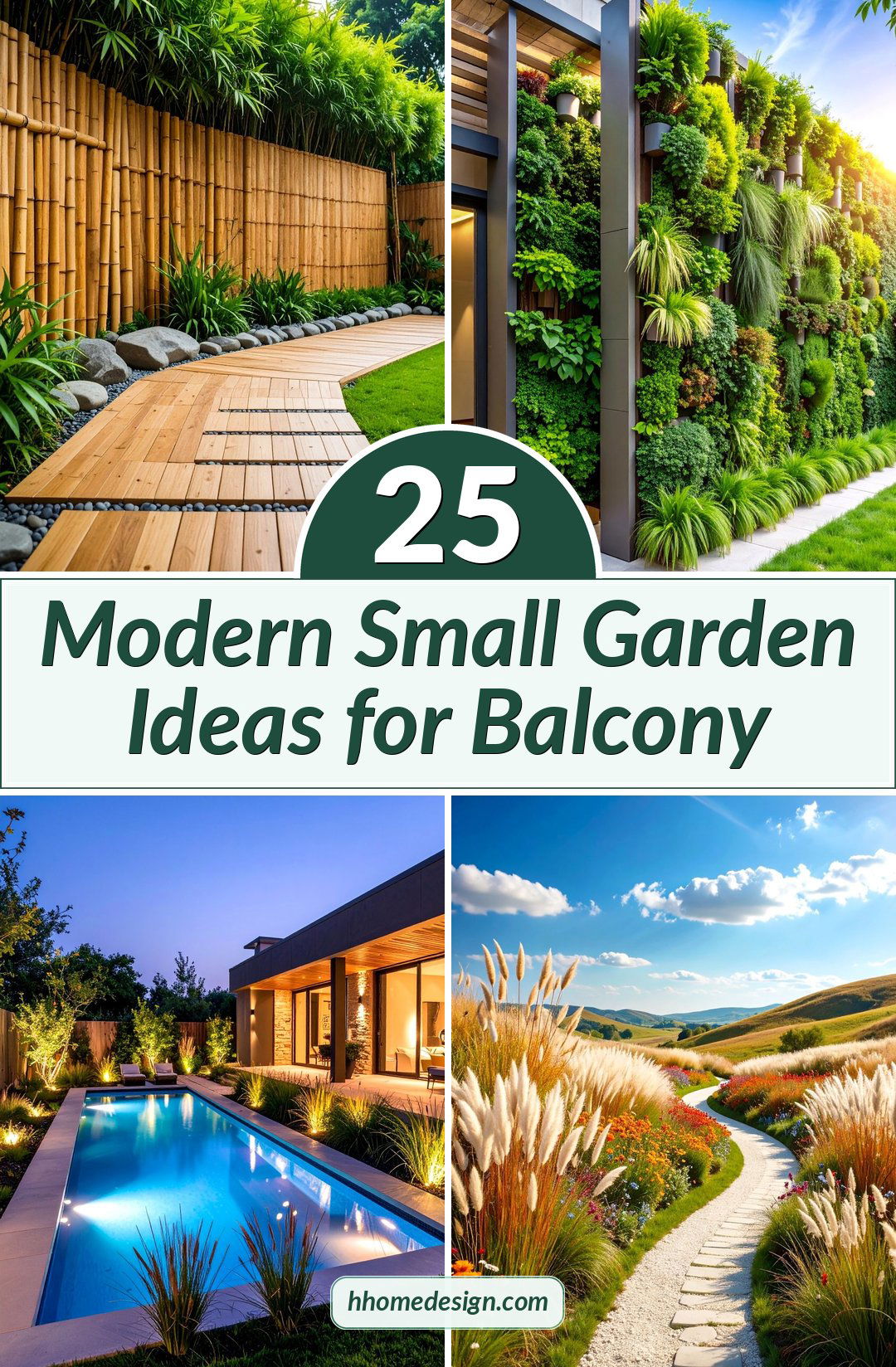
1. Minimalist Zen Garden with Gravel Patterns
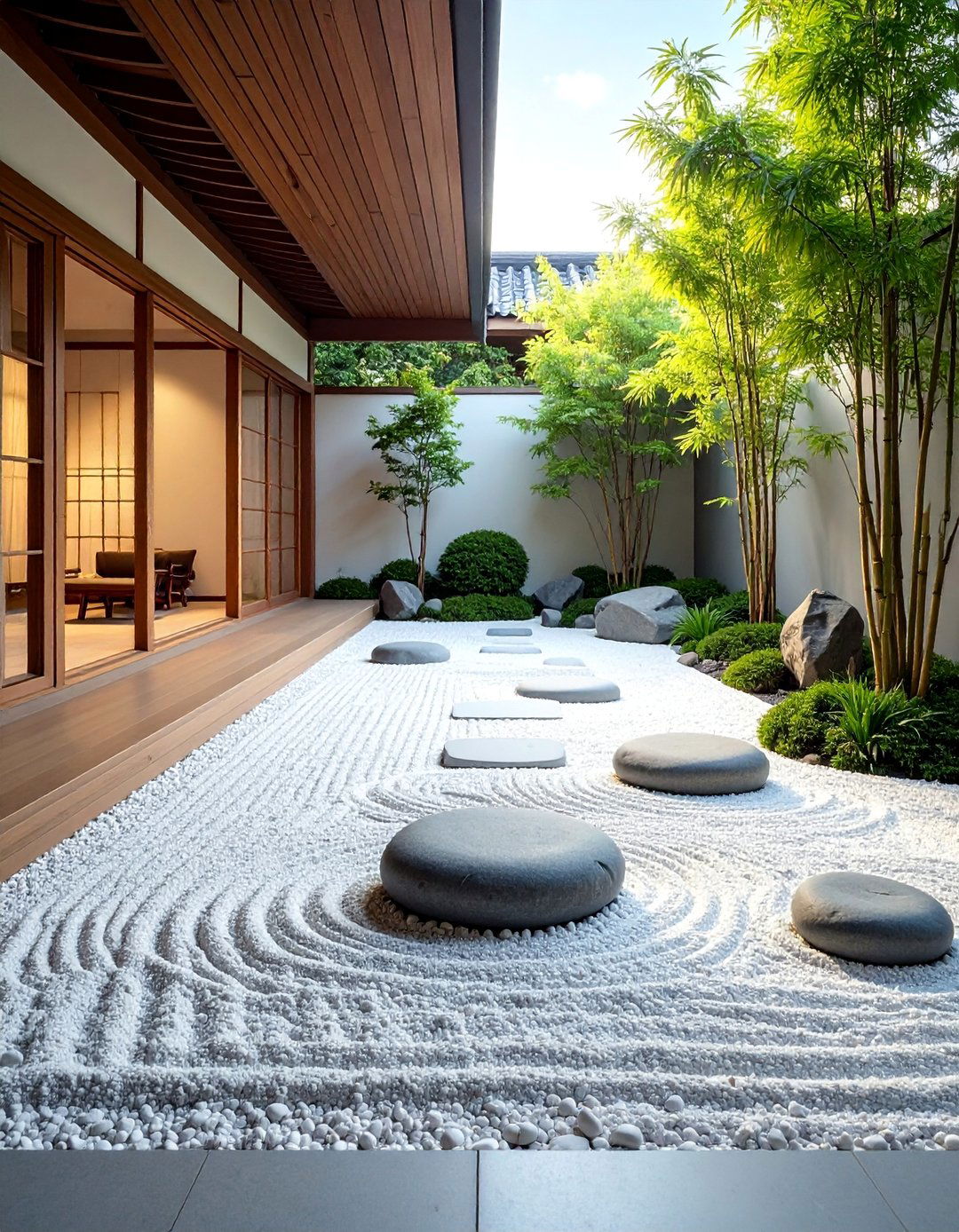
Contemporary zen gardens embrace the essence of tranquility through carefully arranged gravel patterns, strategically placed rocks, and sparse plantings. This design philosophy centers on creating meditative spaces using raked white or grey gravel as the primary foundation, complemented by a few sculptural elements like bamboo or ornamental grasses. The monochromatic palette of whites, greys, and greens provides visual calm while requiring minimal maintenance. Clean geometric lines define the space, often incorporating a single water feature or stone bench for contemplation. This approach maximizes the feeling of spaciousness through intentional negative space, making small areas appear larger while creating a peaceful retreat from urban life.
2. Vertical Living Wall Garden System

Modern vertical gardens revolutionize small space design by transforming blank walls into lush green tapestries. These systems utilize modular planting panels, hydroponic setups, or pocket planters to create stunning living walls that maximize growing space vertically. Contemporary installations often feature automated irrigation systems and LED grow lights for optimal plant health. Plant selections typically include tropical foliage, herbs, succulents, and air-purifying varieties arranged in artistic patterns. The design emphasizes different textures and shades of green while incorporating occasional flowering plants for color accents. This approach not only saves ground space but also improves air quality and creates a dramatic focal point that seamlessly blends nature with modern architecture.
3. Container Garden with Geometric Planters
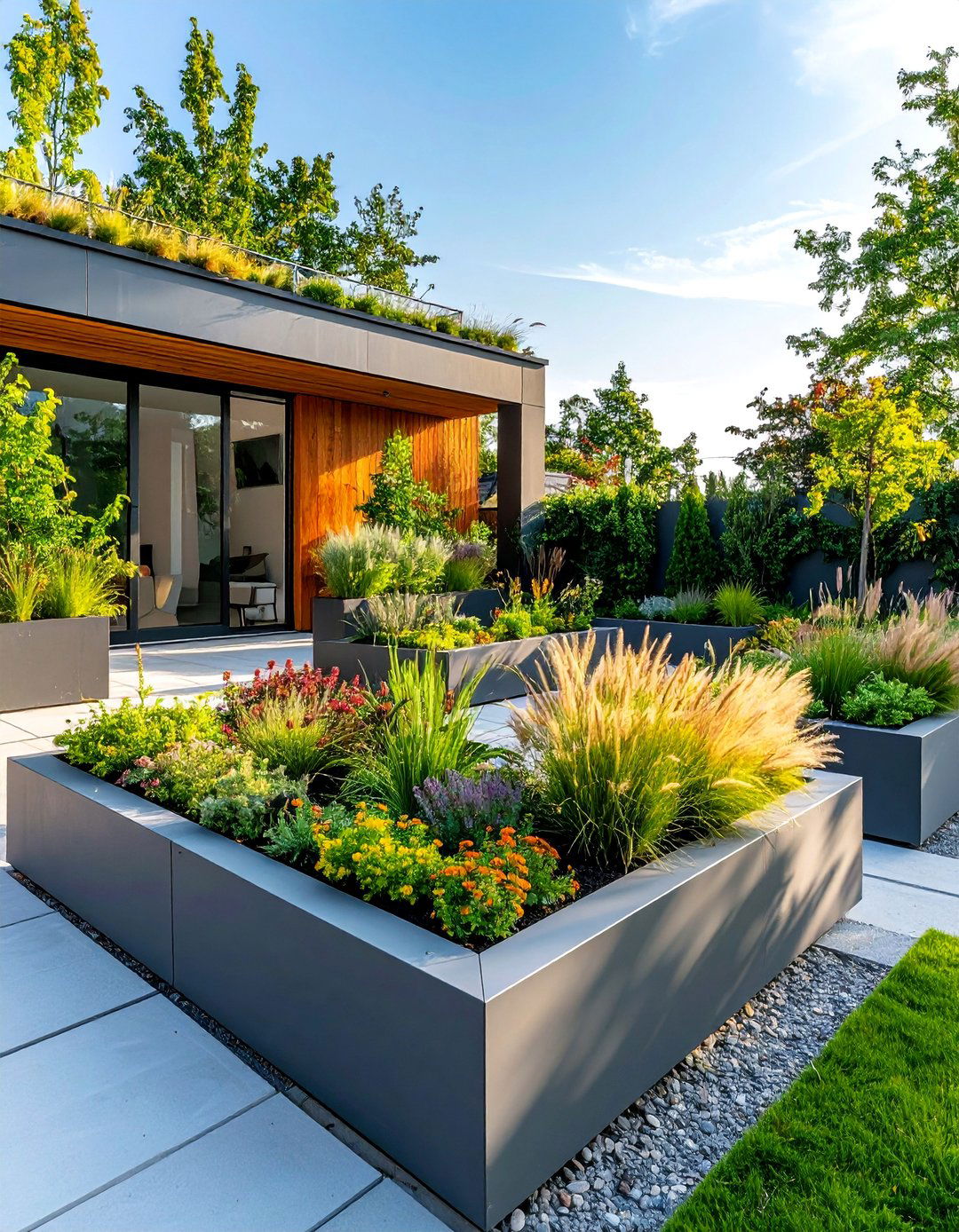
Modern container gardening elevates small spaces through carefully curated collections of geometric planters in various sizes and materials. This design strategy employs sleek rectangular, cylindrical, and cubic containers made from materials like powder-coated steel, concrete, or ceramic to create structured compositions. Plant selections focus on architectural specimens such as ornamental grasses, succulents, and topiary shrubs that complement the clean lines of contemporary planters. Color schemes typically feature monochromatic foliage with occasional seasonal flower accents. The arrangement creates rhythm through repetition and varying heights, while weather-resistant materials ensure year-round appeal. This flexible approach allows for easy reconfiguration and seasonal updates while maintaining sophisticated modern aesthetics.
4. Sustainable Rain Garden with Native Plants

Eco-conscious rain gardens address environmental concerns while creating beautiful landscapes that naturally manage stormwater runoff. These bioswales feature depression areas filled with drought-tolerant native plants, permeable surfaces, and natural stone elements. Design emphasis focuses on creating gently sloping berms planted with indigenous grasses, wildflowers, and shrubs that thrive in both wet and dry conditions. Decorative river rocks and boulders provide visual interest while facilitating drainage. The naturalistic planting scheme attracts beneficial insects, birds, and butterflies while reducing maintenance requirements. This sustainable approach demonstrates environmental stewardship through beautiful design that captures, filters, and slowly releases rainwater while supporting local ecosystems and reducing municipal water usage.
5. Indoor-Outdoor Kitchen Garden Extension

Contemporary edible gardens seamlessly integrate with modern architecture by extending kitchen spaces into outdoor areas through functional herb and vegetable gardens. This design features raised beds, container plantings, and vertical growing systems positioned adjacent to kitchen windows or doors for easy access. Material choices include weathered steel planters, wooden raised beds, and sleek irrigation systems that complement modern home design. Plant selections focus on culinary herbs, salad greens, cherry tomatoes, and compact fruit varieties that provide fresh ingredients while maintaining ornamental appeal. Integrated lighting systems allow for evening harvesting while creating ambiance. This approach combines sustainability with convenience, reducing food miles while providing fresh, organic produce within steps of the kitchen.
6. Modern Water Feature Garden with Reflecting Pool

Sleek water features anchor contemporary small gardens through minimalist reflecting pools, linear fountains, or sculptural water walls that create focal points while adding movement and sound. These designs utilize clean-lined concrete, steel, or stone construction with underwater LED lighting for dramatic evening effects. Surrounding plantings typically feature ornamental grasses, architectural perennials, and evergreen shrubs that complement rather than compete with the water element. The design emphasizes reflection and transparency while incorporating recirculating systems for sustainability. Strategic placement maximizes visual impact while conserving space, often serving dual purposes as seating areas or room dividers. This approach creates tranquil environments that mask urban noise while providing cooling effects through evaporation and visual psychology.
7. Rooftop Terrace Garden with Wind-Resistant Plants

Urban rooftop gardens transform unused spaces into productive green retreats using specialized design strategies that address wind, weight, and exposure challenges. Lightweight planters, raised beds, and modular systems accommodate structural limitations while creating stunning elevated gardens. Plant selections emphasize wind-resistant varieties such as ornamental grasses, succulents, herbs, and compact shrubs that thrive in exposed conditions. Design elements include privacy screens, shade structures, and wind barriers that create comfortable microclimates. Drainage systems prevent water damage while capturing rainwater for irrigation. This approach maximizes urban density benefits by creating private outdoor spaces above ground level while contributing to building insulation, air quality improvement, and urban heat island reduction through strategic green infrastructure implementation.
8. Japanese-Inspired Courtyard with Timber Elements
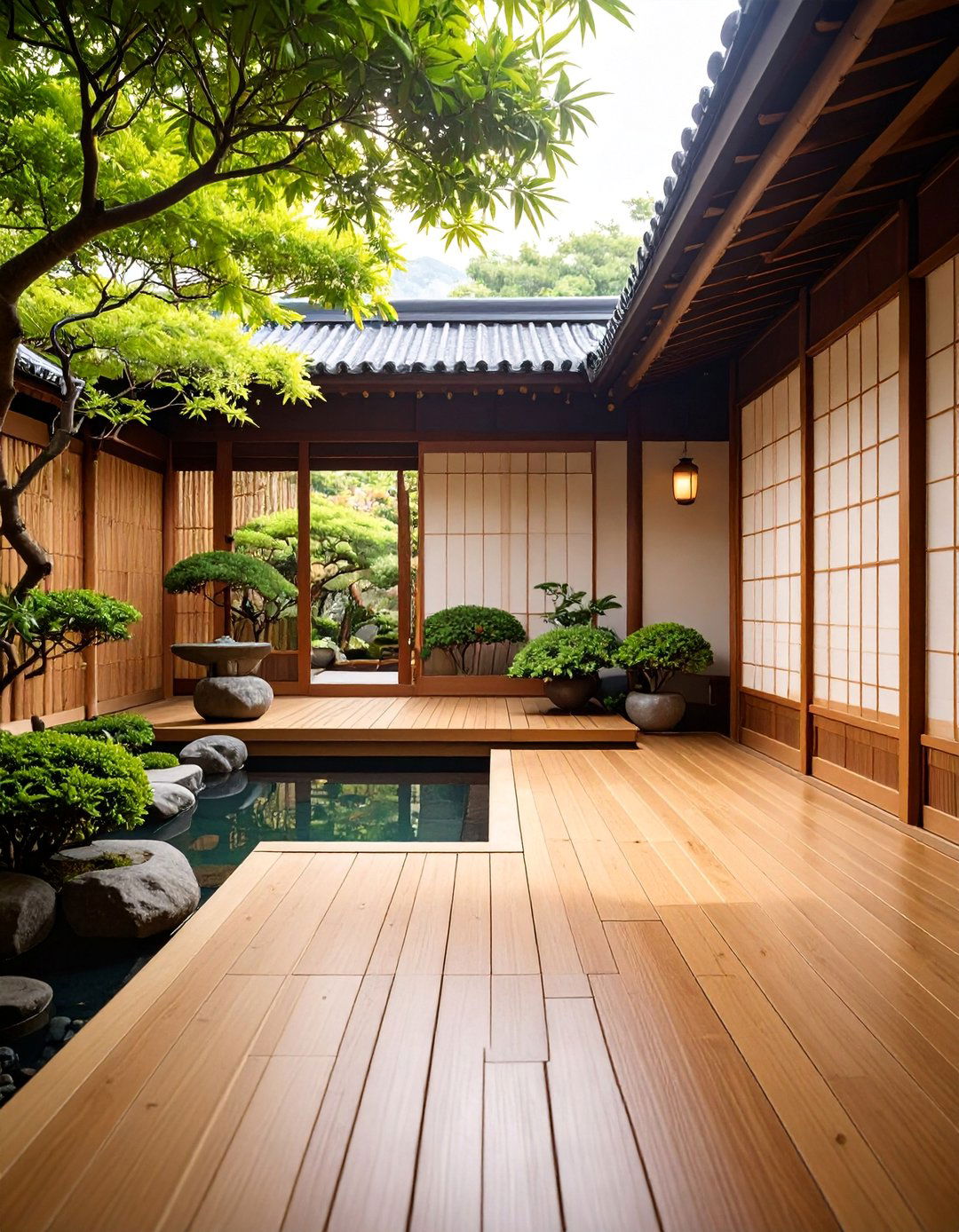
Modern interpretations of Japanese garden design create serene courtyards through careful balance of natural materials, sculptural plants, and architectural elements. Timber decking, cedar fencing, and wooden planters provide warm organic textures that complement minimalist plantings of bamboo, Japanese maples, and ornamental grasses. Design principles emphasize asymmetrical balance, seasonal interest, and the interplay between solid and void spaces. Stone elements include carefully placed boulders, gravel pathways, and water basins that enhance the contemplative atmosphere. Subdued lighting creates evening ambiance while highlighting key features. This approach creates intimate spaces that feel larger through borrowed landscape principles and careful sight line management, offering peaceful retreats that celebrate natural beauty and cultural aesthetics.
9. Succulent Rock Garden with Gravel Mulch

Contemporary succulent gardens showcase drought-resistant plants through artistic arrangements of varied textures, forms, and colors set against mineral backdrops. Design strategies utilize different gravel types, decorative stones, and architectural rocks to create interesting topography and excellent drainage. Plant selections feature diverse succulents including agaves, sedums, echeverias, and architectural specimens that provide year-round structure and seasonal color changes. Color schemes often emphasize silvery-blue, purple, and green foliage with occasional bright flower accents. Hardscaping elements include steel edging, concrete planters, and sculptural rocks that complement the plants' architectural qualities. This low-maintenance approach thrives in sunny locations while conserving water and creating striking visual compositions that evolve with plant growth and seasonal changes.
10. Small Space Herb Spiral Garden
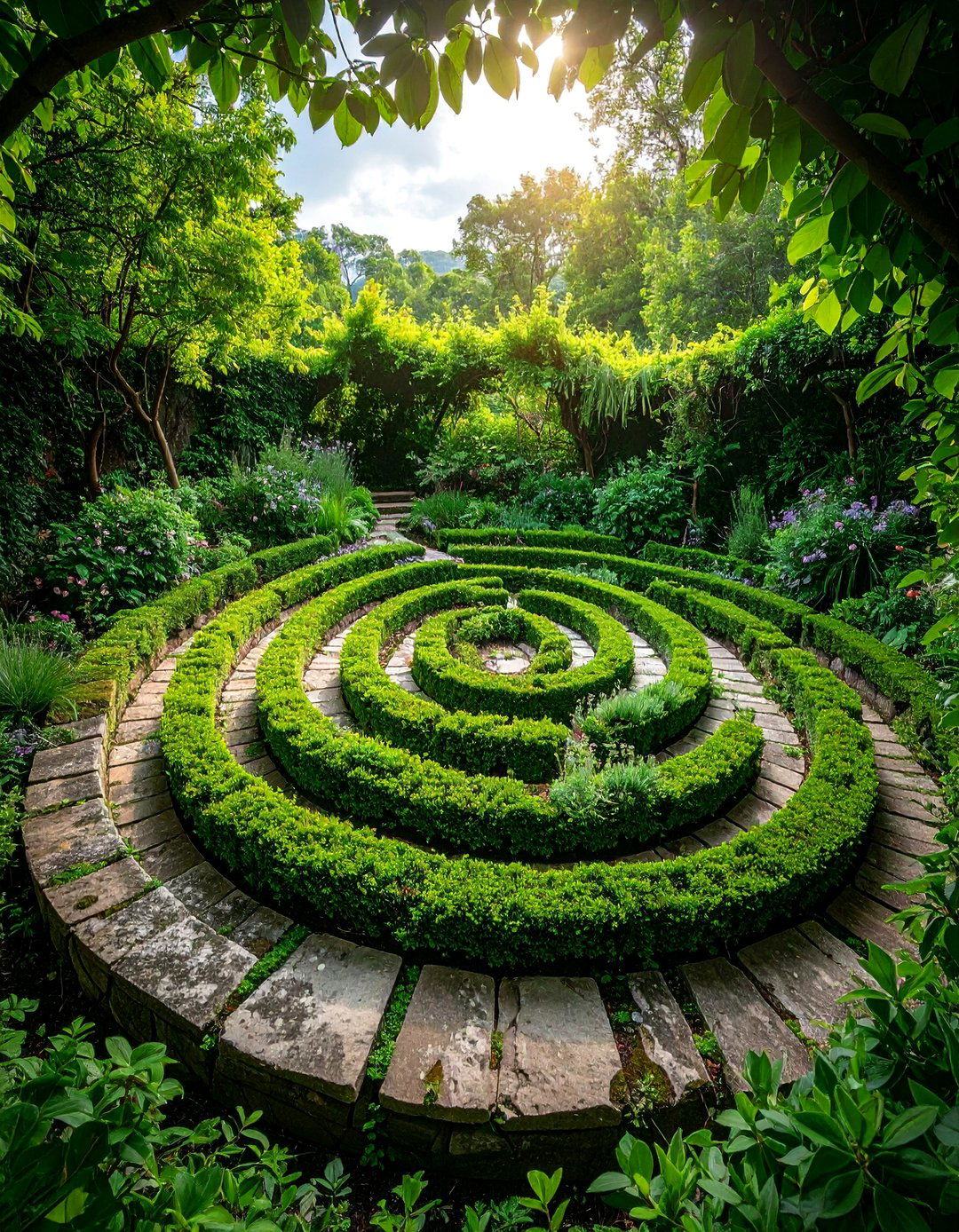
Permaculture-inspired herb spirals maximize growing space through vertical design while creating diverse microclimates for various culinary and medicinal plants. These raised structures utilize stone, timber, or recycled materials arranged in ascending spirals that provide different sun, moisture, and drainage conditions. Plant selections include Mediterranean herbs at the top, moisture-loving varieties at the bottom, and diverse aromatic plants throughout. Design benefits include easy harvesting access, efficient water usage, and visual appeal through structural architecture. The spiral form creates more growing edge than traditional flat beds while facilitating companion planting relationships. This productive approach combines functionality with aesthetics, providing fresh herbs while creating sculptural garden features that demonstrate sustainable design principles and permaculture techniques.
11. Modern Prairie Meadow with Ornamental Grasses

Contemporary meadow gardens recreate natural grassland ecosystems through carefully choreographed plantings of ornamental grasses, wildflowers, and perennials that provide year-round interest with minimal maintenance. Design strategies emphasize naturalistic drifts, seasonal succession, and wildlife habitat creation. Plant selections include native and adapted species that support pollinators while providing structural beauty through varied heights, textures, and seed heads. Color palettes focus on subtle greens, browns, and seasonal wildflower accents that change throughout growing seasons. Mowing pathways create access while maintaining wild character. This ecological approach supports biodiversity while requiring fewer inputs than traditional lawns, creating dynamic landscapes that celebrate regional plant communities and natural beauty through contemporary interpretation of traditional meadow ecosystems.
12. Contemporary Shade Garden with Architectural Foliage
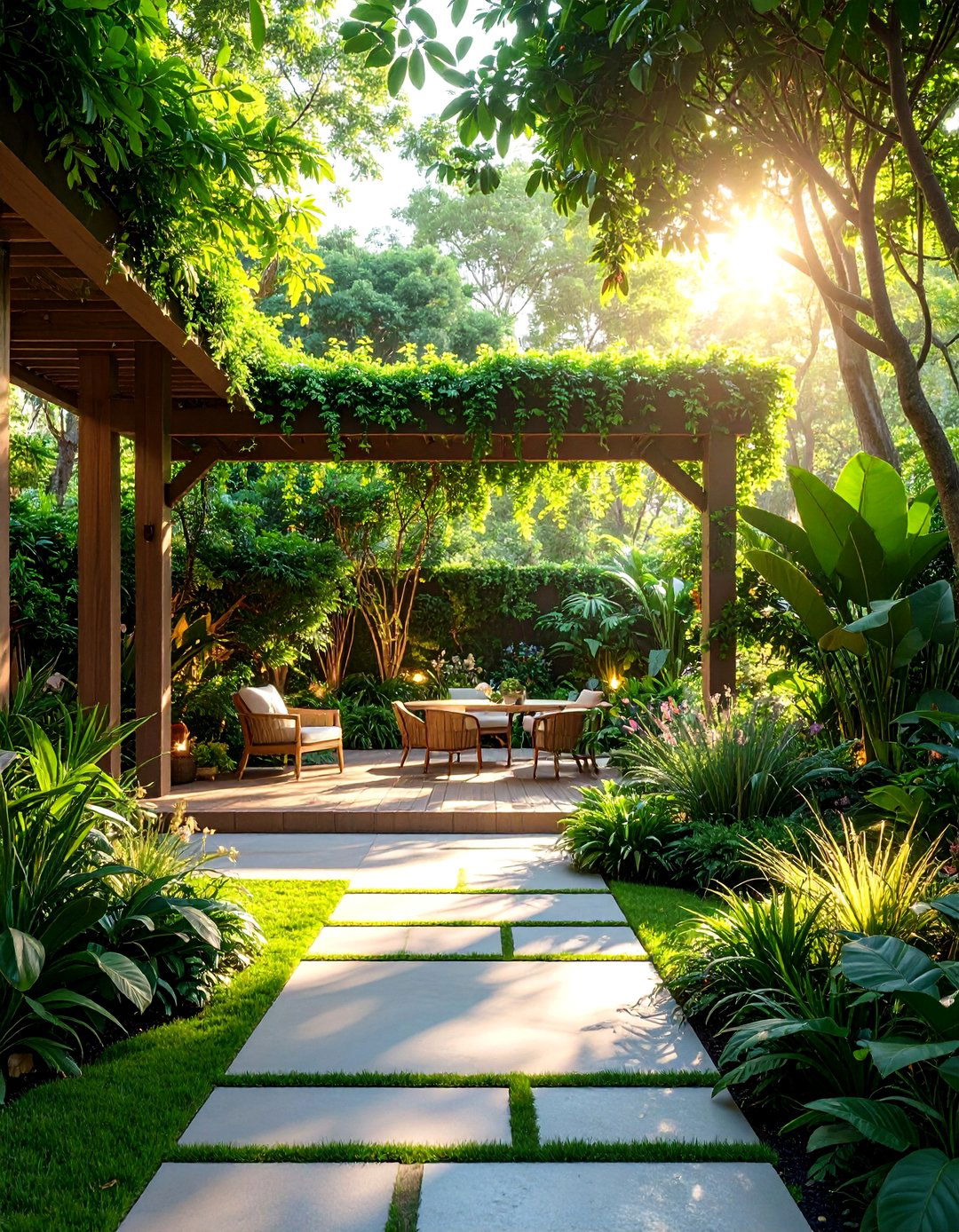
Modern shade gardens transform challenging low-light areas through strategic use of bold foliage plants, textural contrasts, and innovative lighting solutions. Plant selections emphasize architectural leaves, varied green tones, and interesting forms including hostas, ferns, tropical specimens, and evergreen shrubs. Design principles utilize layering, repetition, and sculptural elements to create depth and interest without relying on flowers. Hardscaping includes contemporary materials like steel edging, concrete pavers, and modern water features that complement foliage displays. Artificial lighting extends usability while highlighting plant textures and forms. This approach proves that shaded spaces can be as compelling as sunny gardens through thoughtful plant selection and design strategies that embrace rather than fight natural conditions.
13. Compact Greenhouse Garden Room Extension

Modern greenhouse design integrates seamlessly with home architecture while providing year-round growing capabilities in minimal space. Contemporary structures feature clean lines, energy-efficient glazing, and integrated ventilation systems that complement modern homes. Interior design includes raised beds, vertical growing systems, and efficient storage solutions that maximize productivity. Plant selections encompass vegetables, herbs, flowers, and tropical specimens that extend growing seasons. Climate control systems include automated watering, heating, and ventilation that maintain optimal conditions. This approach creates functional outdoor rooms that serve multiple purposes including plant cultivation, relaxation spaces, and architectural features. The integration of indoor-outdoor living concepts makes small gardens more versatile while providing controlled environments for specialized plant collections and year-round gardening activities.
14. Sculptural Topiary Garden with Boxwood Spheres
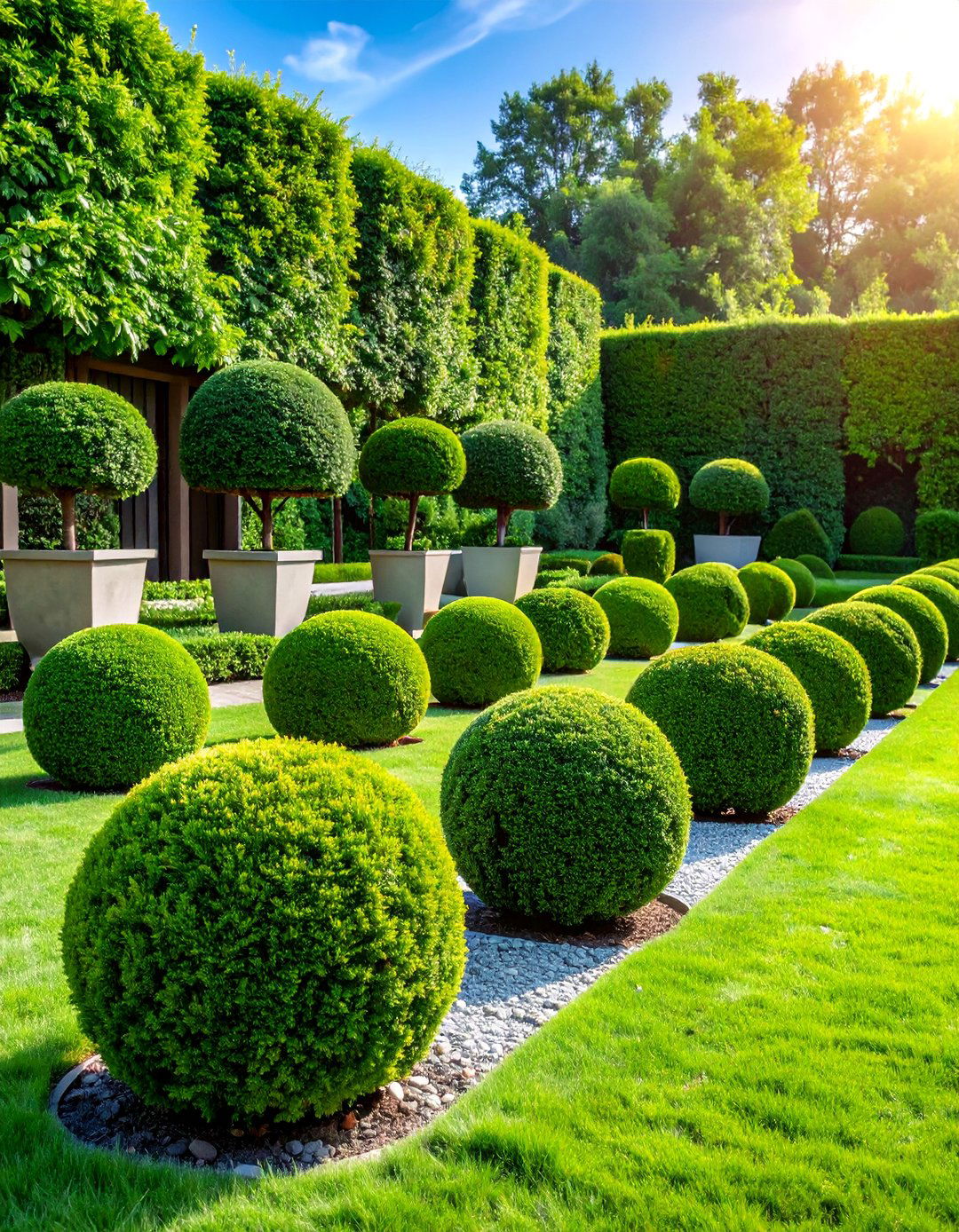
Contemporary topiary gardens create striking geometric compositions through precisely shaped evergreen plants that provide structure and sophistication year-round. Modern interpretations favor clean geometric forms like spheres, cubes, and cylinders arranged in rhythmic patterns rather than complex figurative shapes. Plant selections typically feature boxwood, yew, or privet varieties that respond well to shaping while maintaining compact growth habits. Design strategies include grouping different sizes, using repetition for unity, and incorporating negative space for visual breathing room. Hardscaping elements include contemporary planters, gravel surfaces, and minimal material palettes that highlight plant architecture. This formal approach creates elegant focal points while demonstrating gardening skill and providing permanent structure that anchors seasonal plantings and creates sophisticated outdoor rooms.
15. Smart Garden with Automated Irrigation Systems
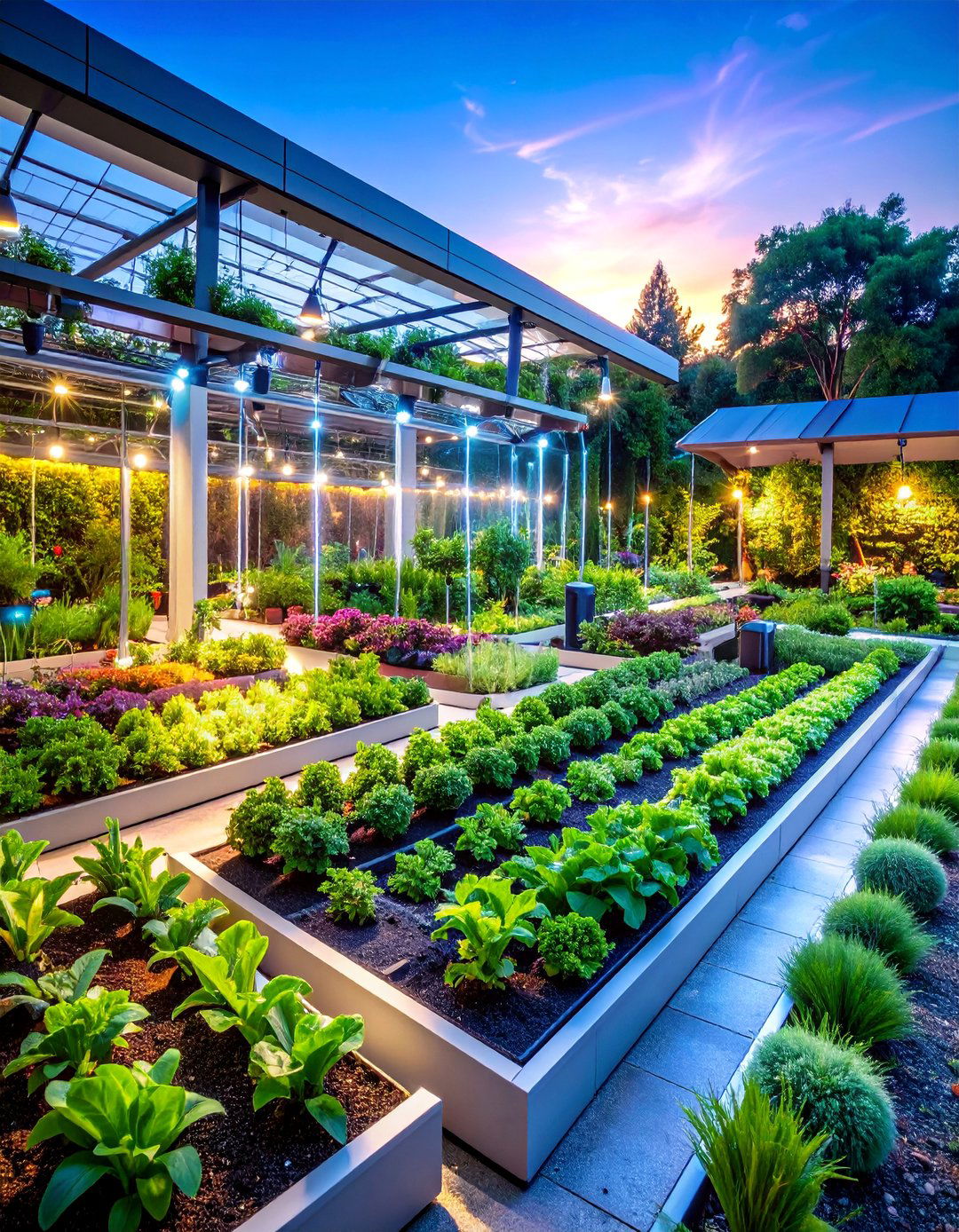
Technology-integrated gardens maximize efficiency through automated systems that monitor soil moisture, weather conditions, and plant needs while providing remote control capabilities. Modern installations include smart irrigation controllers, soil sensors, and weather stations that optimize water usage and plant health. Design integration conceals technology within landscape elements while maintaining aesthetic appeal. Plant selections often favor drought-tolerant species that work well with precision watering systems. Monitoring applications provide real-time data about garden conditions while learning algorithms improve efficiency over time. This high-tech approach appeals to busy lifestyles while demonstrating sustainable resource management through precise application of water, fertilizer, and care. The integration of technology and nature creates gardens that thrive with minimal intervention while maximizing environmental efficiency.
16. Monochromatic White Garden with Silver Foliage

Sophisticated monochromatic gardens create serene compositions through limited color palettes that emphasize texture, form, and seasonal changes rather than bright colors. White-themed gardens feature silver-leafed plants, white-flowering varieties, and pale green foliage that creates luminous effects in different lighting conditions. Plant selections include artemisia, lamb's ear, white roses, jasmine, and architectural grasses that provide varied textures within the restricted palette. Design strategies utilize layering, repetition, and contrasting forms to create interest without color variation. Evening lighting enhances the ethereal quality while extending usability. This elegant approach demonstrates sophisticated design principles while creating calming environments that feel larger and more unified than multi-colored plantings, proving that restraint often creates more impact than abundance.
17. Contemporary Meadow Garden with Wildflower Drifts
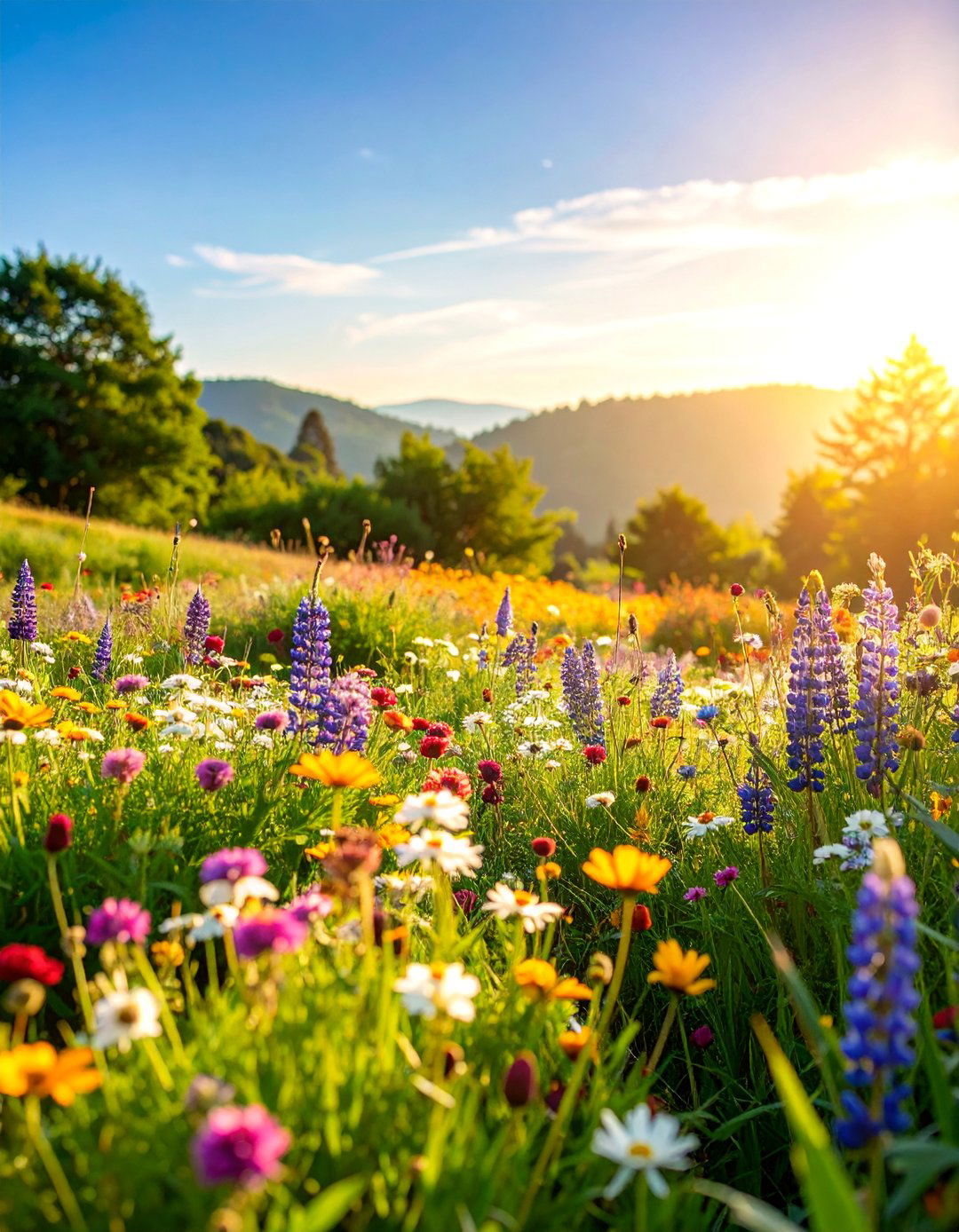
Modern wildflower gardens reinterpret natural meadows through designed plant communities that provide habitat while creating beautiful seasonal displays. Design strategies emphasize naturalistic drifts, companion planting, and succession blooming that maintains interest throughout growing seasons. Plant selections include native wildflowers, ornamental grasses, and pollinator-friendly species arranged in flowing patterns rather than formal rows. Maintenance approaches include selective mowing, seed collection, and natural regeneration that reduces input requirements. This ecological design supports butterflies, bees, and beneficial insects while creating dynamic landscapes that change seasonally. The meadow approach works well in small spaces through careful plant selection and design that maximizes diversity while maintaining visual cohesion and supporting local ecosystems through increased biodiversity and reduced maintenance requirements.
18. Modern Courtyard with Steel and Concrete Features

Industrial materials create striking contemporary courtyards through bold use of weathering steel, polished concrete, and architectural plants that complement urban environments. Design strategies emphasize clean lines, geometric forms, and material contrasts that create sophisticated outdoor rooms. Plant selections favor structural specimens like ornamental grasses, sculptural agaves, and architectural trees that complement rather than soften hard materials. Water features often utilize linear channels, reflecting pools, or sculptural fountains that enhance the modern aesthetic. Lighting design highlights textures and creates dramatic evening effects. This bold approach celebrates urban architecture while creating functional outdoor spaces that serve as extensions of modern interiors, demonstrating how industrial materials can create beautiful and livable garden environments.
19. Compact Fruit and Vegetable Garden Design

Space-efficient food gardens maximize productivity through vertical growing, succession planting, and intensive cultivation methods that provide fresh produce in minimal space. Design strategies include raised beds, trellises, and container systems that optimize growing conditions while maintaining aesthetic appeal. Plant selections emphasize compact varieties, dwarf fruit trees, and high-yield vegetables that provide maximum nutrition per square foot. Companion planting relationships improve pest control and soil health while succession sowing ensures continuous harvests. Preservation of growing space includes integrated composting systems and efficient irrigation that support plant health. This productive approach combines sustainability with self-sufficiency while demonstrating that small spaces can contribute significantly to household food security and nutrition through careful planning and intensive management.
20. Bamboo Garden Screen with Asian-Inspired Elements

Contemporary bamboo gardens create privacy and architectural interest through strategic use of clumping bamboo varieties that provide screening without invasive spreading. Design elements include timber decking, stone pathways, and water features that complement bamboo's vertical lines and rustling sounds. Plant selections favor non-invasive clumping species that provide dense screening while maintaining controlled growth habits. Additional plantings include understory ferns, ornamental grasses, and flowering perennials that complement bamboo's texture. Lighting design creates dramatic shadows and highlights bamboo's natural movement. This approach provides privacy solutions while creating serene environments that filter wind and noise. The fast growth and architectural qualities make bamboo excellent for contemporary gardens that need quick establishment and year-round screening with minimal maintenance requirements.
21. Desert Modern Garden with Cacti and Agaves

Xerophytic gardens celebrate arid-adapted plants through striking compositions of cacti, agaves, and drought-tolerant perennials that thrive with minimal water while providing dramatic architectural interest. Design strategies utilize gravel mulches, boulder accents, and decomposed granite pathways that complement desert plant forms. Plant selections include varied shapes, sizes, and seasonal interest through flowers and fruit displays. Color schemes emphasize silvery-blues, purple-tinged foliage, and bright seasonal blooms against neutral mineral backdrops. Hardscaping materials include weathered steel, natural stone, and concrete elements that enhance rather than compete with plant architecture. This sustainable approach thrives in hot, dry conditions while requiring minimal irrigation and maintenance, creating striking landscapes that celebrate natural adaptation while demonstrating water-wise gardening principles.
22. Contemporary Moss Garden with Stone Pathways
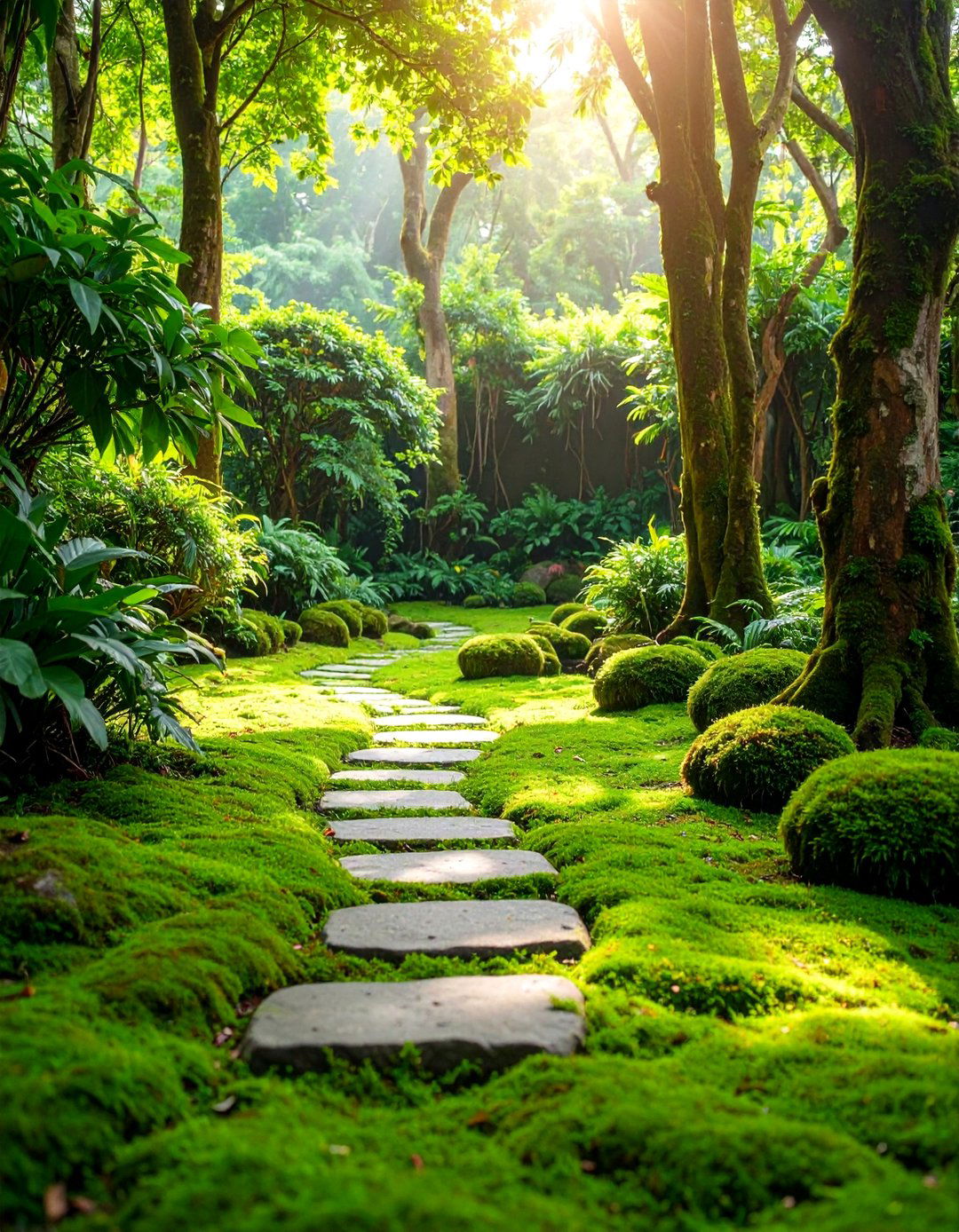
Modern moss gardens create enchanting low-maintenance landscapes through cultivation of various moss species that provide velvety textures and luminous green colors year-round. Design strategies emphasize moisture retention, filtered light, and acidic soil conditions that support moss establishment and growth. Hardscaping includes natural stone pathways, timber steps, and water features that maintain humidity while providing access. Plant companions include ferns, small hostas, and woodland specimens that complement moss textures without overwhelming delicate growth. This approach works exceptionally well in shaded areas where traditional lawns struggle, creating magical environments that feel larger through careful proportions and pathway design. The low-maintenance requirements and unique aesthetic make moss gardens ideal for contemporary landscapes that celebrate subtle beauty and environmental adaptation.
23. Modular Raised Bed Garden System
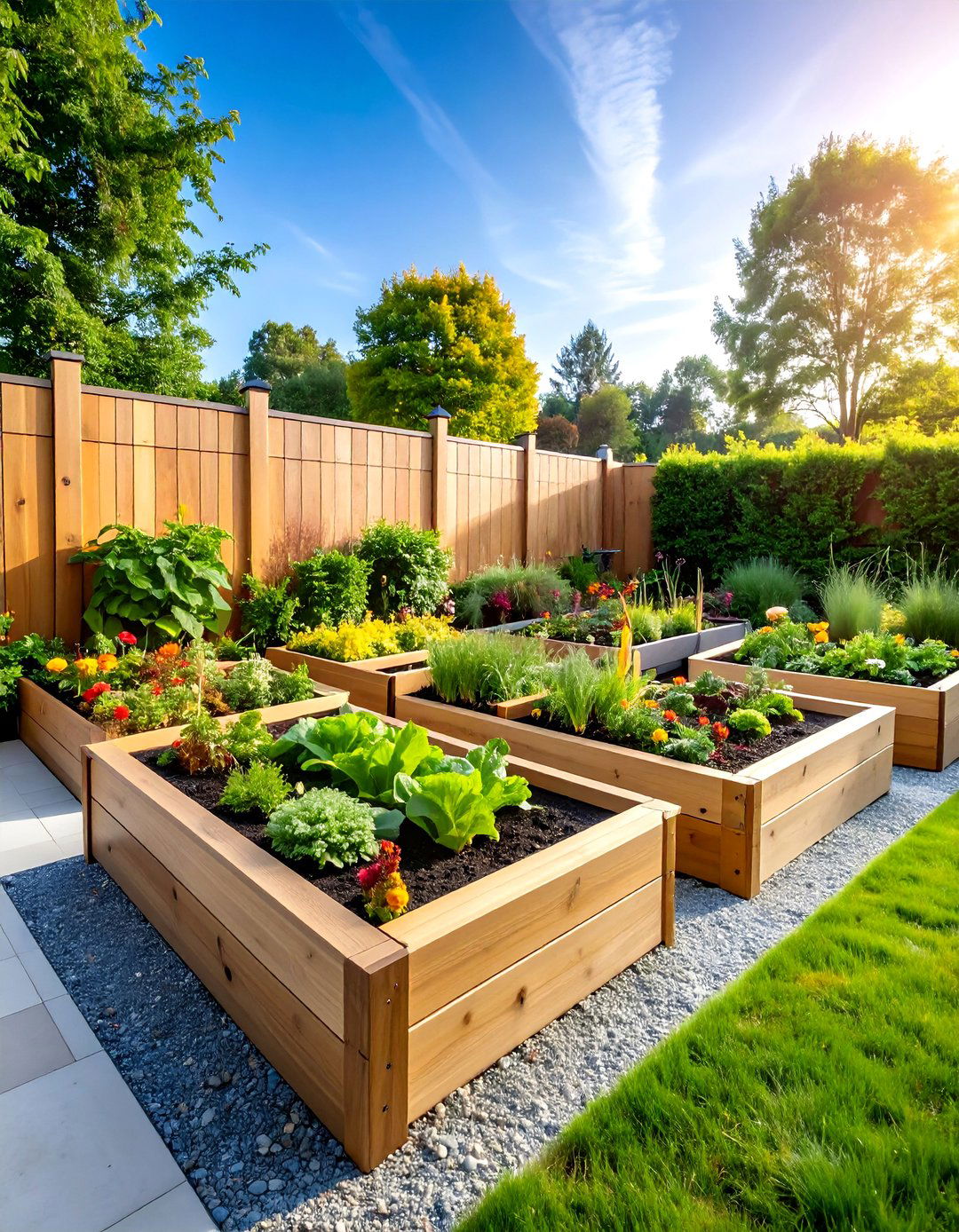
Contemporary raised bed systems maximize growing efficiency through modular designs that accommodate changing needs while maintaining clean aesthetic lines. Materials include weathered steel, cedar, or composite lumber arranged in geometric patterns that complement modern architecture. Design flexibility allows expansion, reconfiguration, and seasonal changes while maintaining visual unity. Plant selections optimize space through succession planting, vertical supports, and companion relationships that improve productivity and pest management. Integrated irrigation systems ensure consistent moisture while mulching strategies conserve water and suppress weeds. This systematic approach appeals to organized gardeners while providing maximum productivity in minimal space through efficient design and intensive cultivation methods that demonstrate sustainable food production principles.
24. Contemporary Fire Garden with Heat-Tolerant Plants
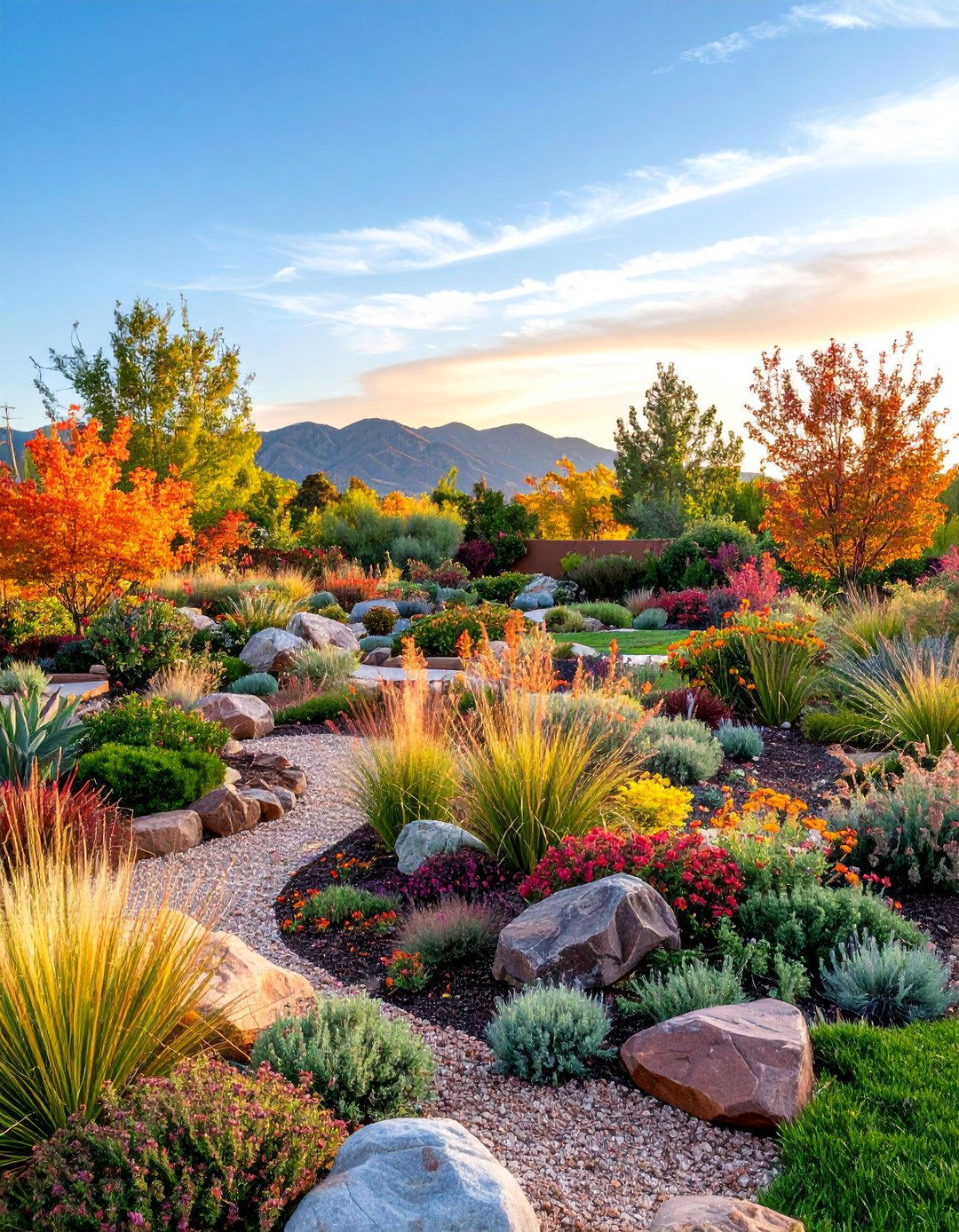
Modern fire-resistant gardens address wildfire concerns through strategic plant selection and design that creates defensible space while maintaining beauty and functionality. Plant selections emphasize low-flammability species, succulent ground covers, and fire-resistant trees that provide beauty without increasing risk. Design strategies include strategic plant spacing, mineral mulches, and irrigation systems that maintain plant health during dry periods. Hardscaping materials include non-combustible pathways, steel planters, and stone features that provide fire breaks while enhancing aesthetic appeal. This responsible approach demonstrates how contemporary design can address environmental challenges while creating beautiful landscapes that protect property and support community safety through thoughtful plant selection and design principles that balance beauty with practical fire prevention strategies.
25. Multi-Seasonal Interest Garden with Four-Season Plants
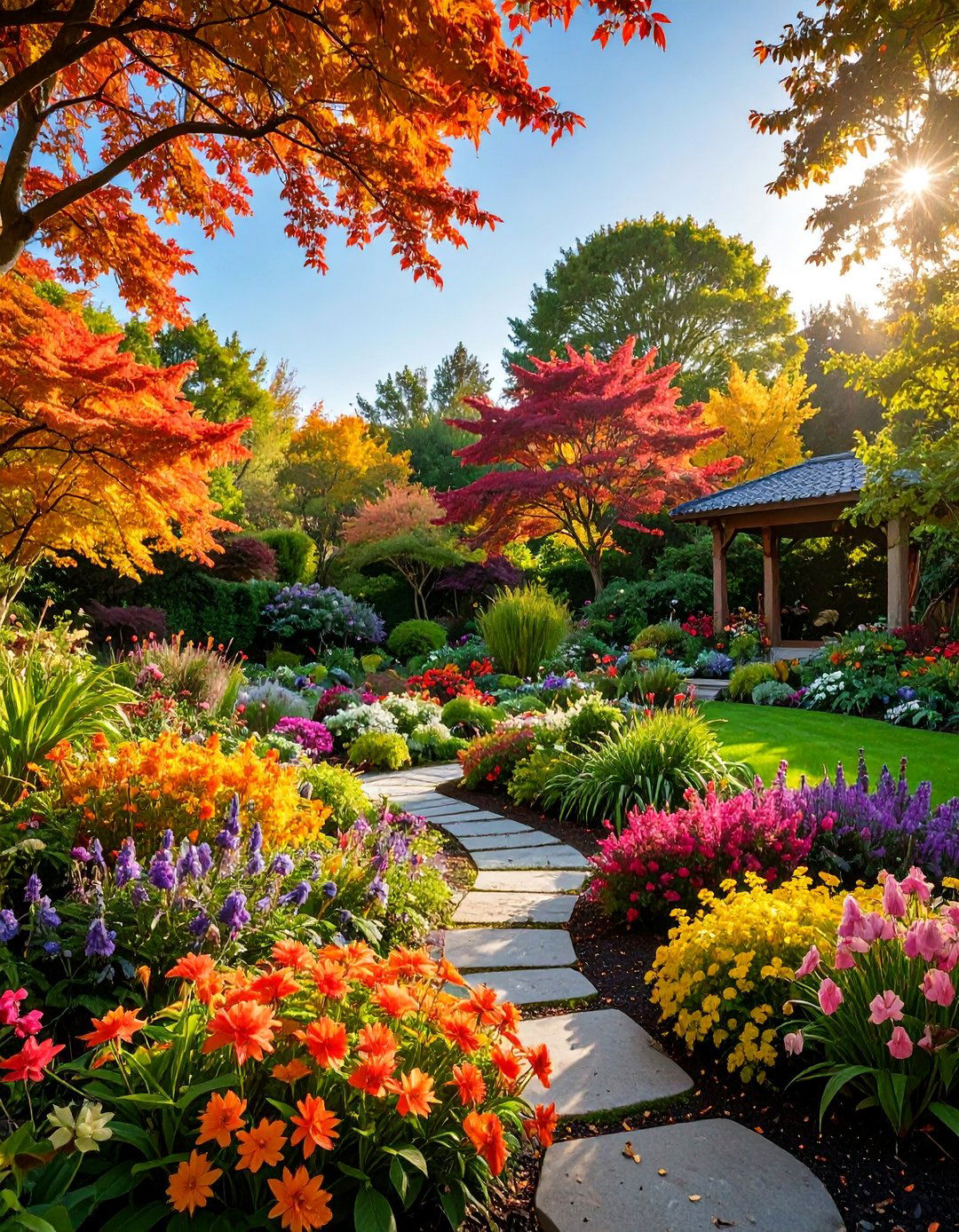
Year-round gardens maintain beauty through careful selection of plants that provide interest across all seasons through varied flowering times, foliage changes, fruit displays, and structural elements. Design strategies include layering deciduous and evergreen species while incorporating plants with interesting bark, seed heads, and winter forms. Plant selections provide succession of seasonal highlights while maintaining underlying structure through permanent framework plants. This approach includes spring bulbs, summer perennials, autumn foliage, and winter architecture that creates constantly changing displays. Strategic plant placement maximizes seasonal views from indoor spaces while providing wildlife habitat throughout the year. This comprehensive approach ensures gardens remain engaging and beautiful regardless of season while supporting biodiversity and providing year-round interest that justifies space investment in small garden situations.
Conclusion:
Modern small garden design proves that exceptional outdoor spaces aren't defined by size but by thoughtful planning and creative vision. These contemporary approaches demonstrate how sustainable practices, innovative materials, and strategic plant selection can transform any compact area into a stunning garden retreat. From vertical living walls to drought-resistant landscapes, today's small gardens maximize functionality while supporting environmental stewardship. By embracing these design concepts, gardeners can create personalized outdoor sanctuaries that enhance daily life, support local ecosystems, and provide year-round beauty regardless of space limitations.


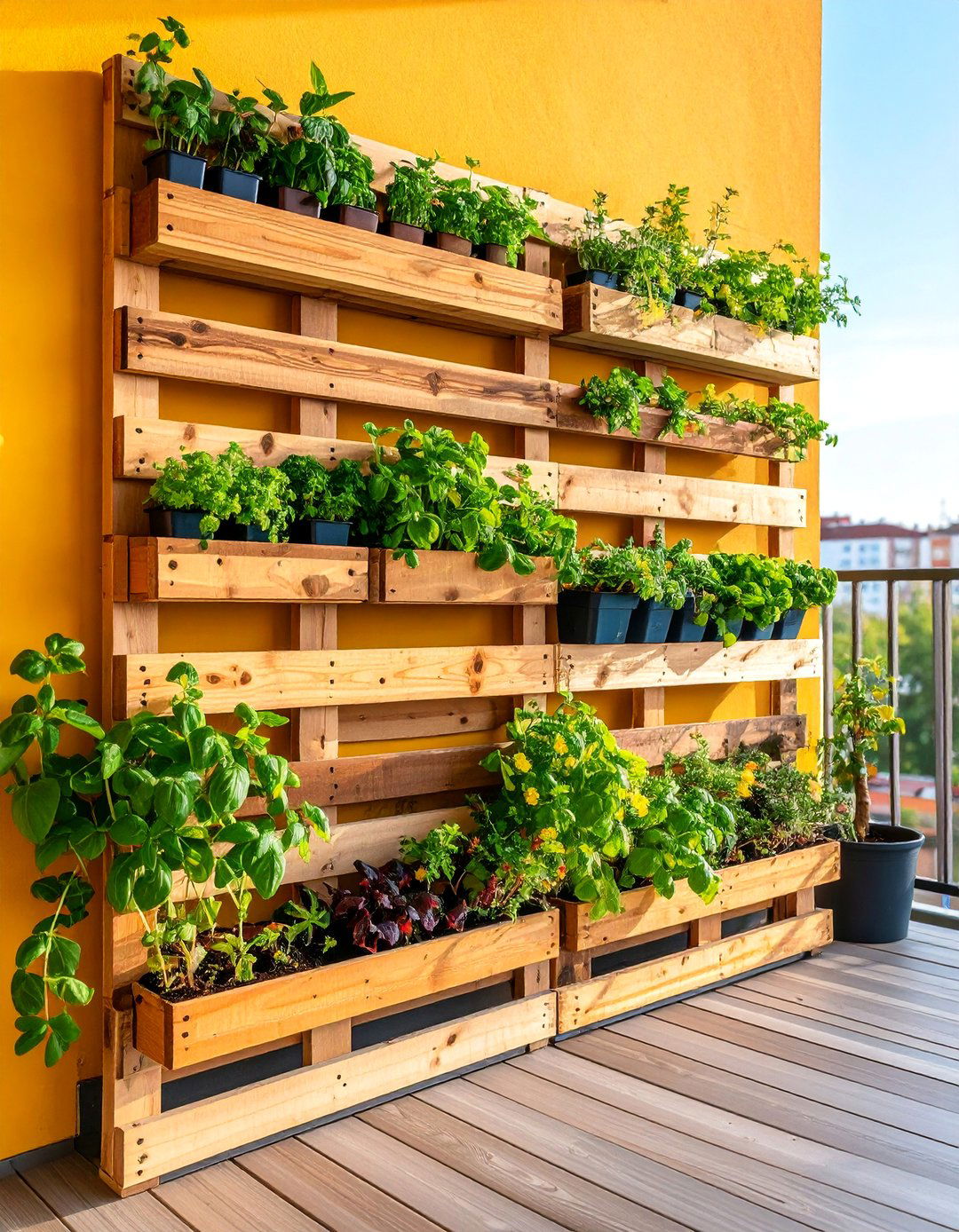

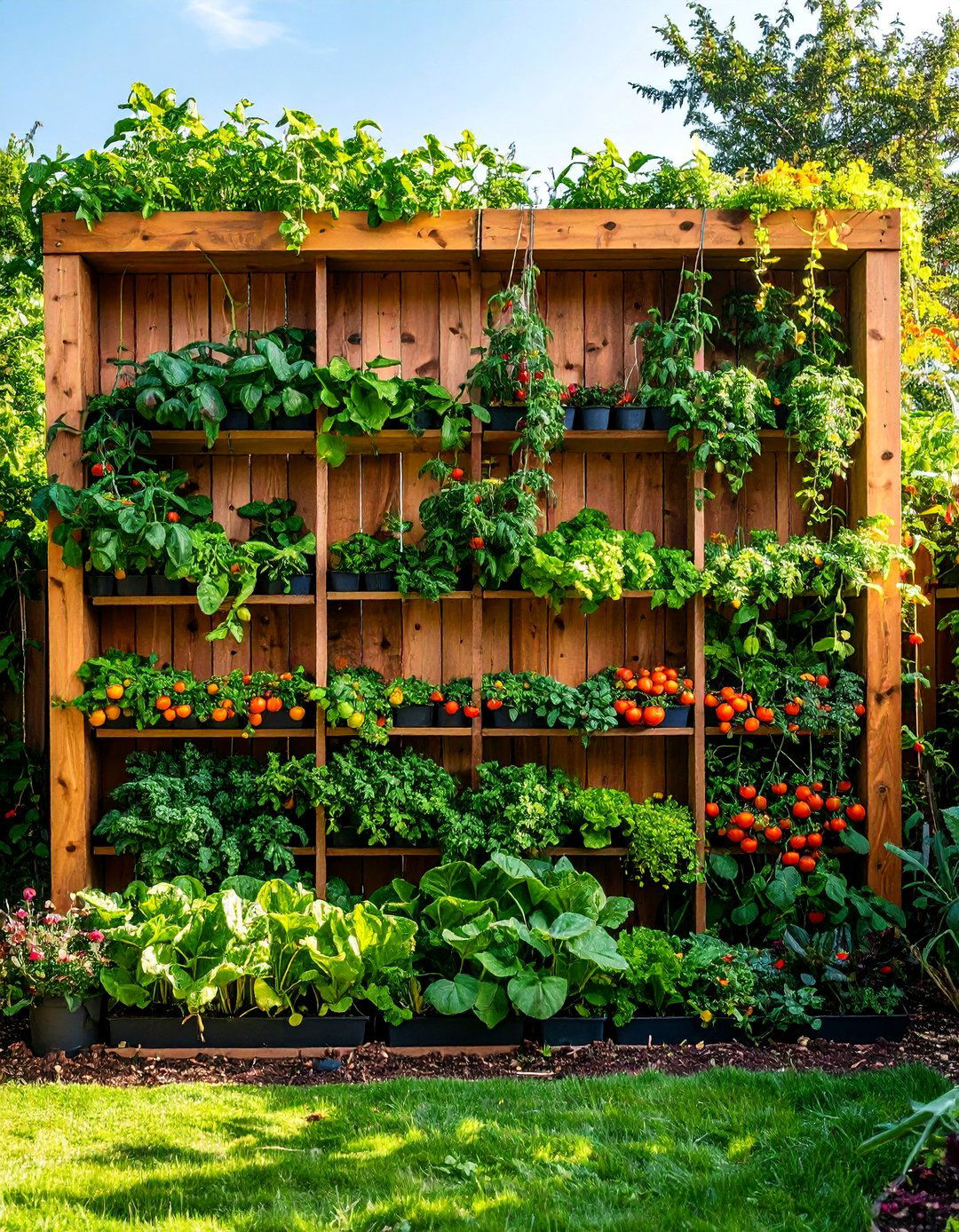
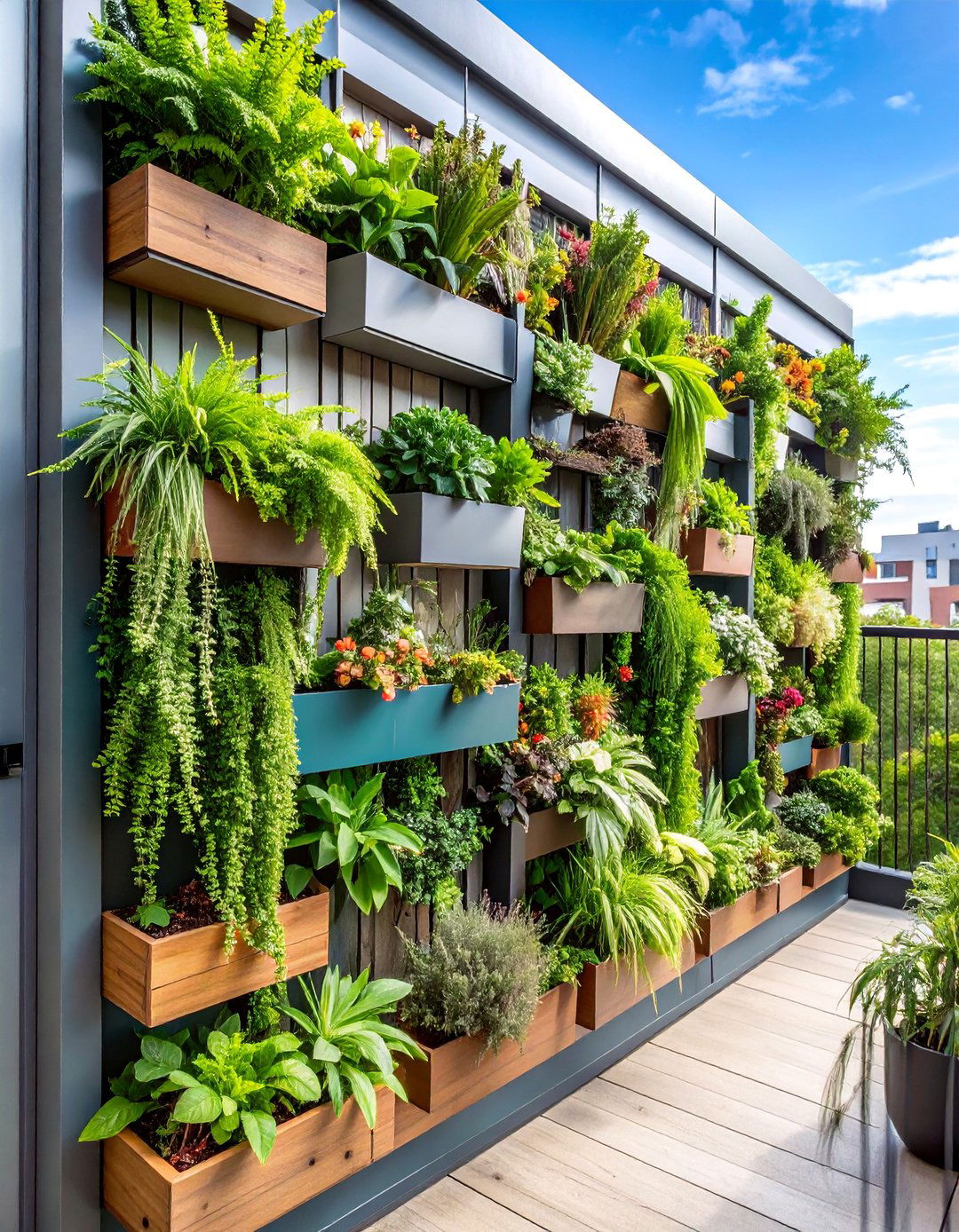

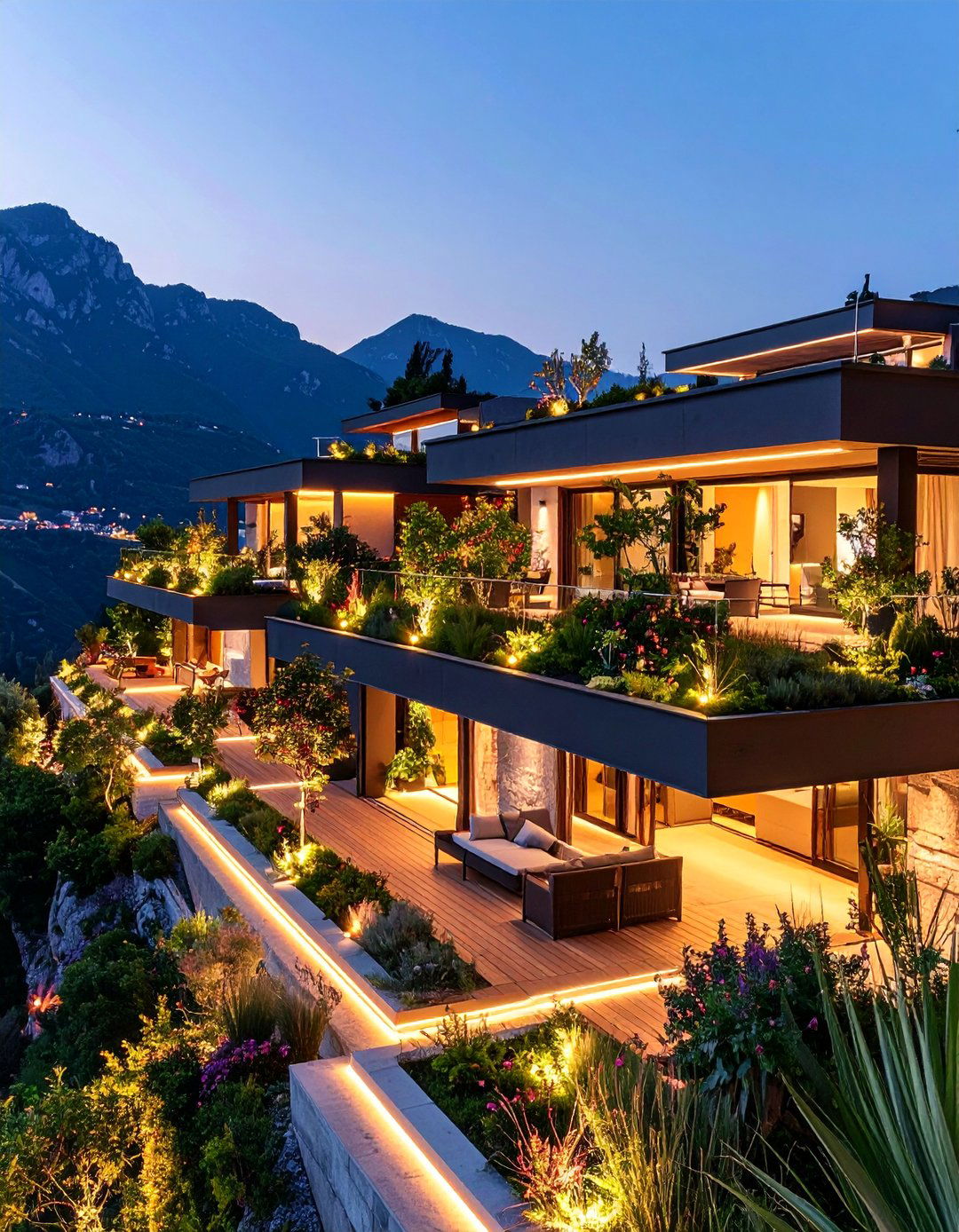







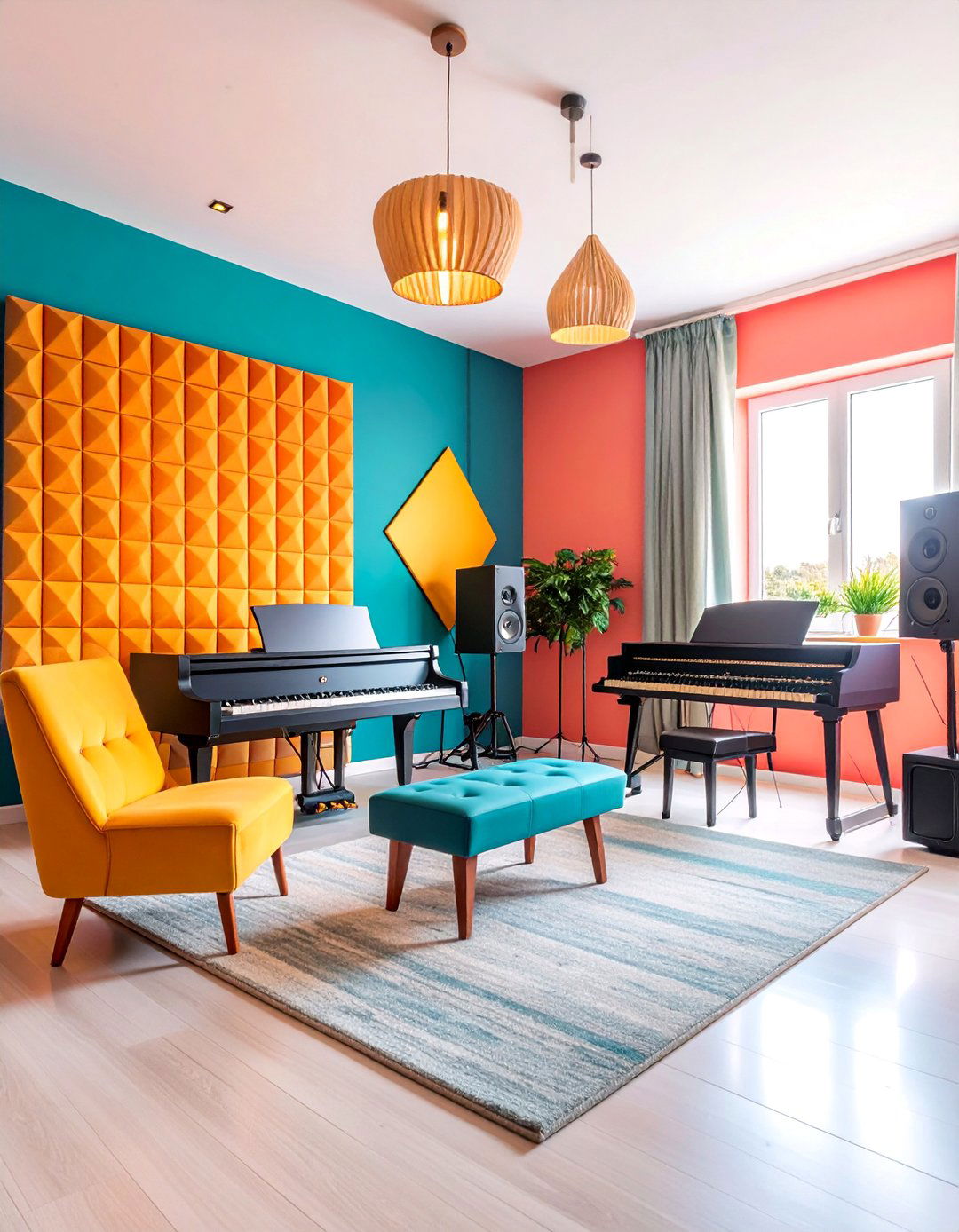
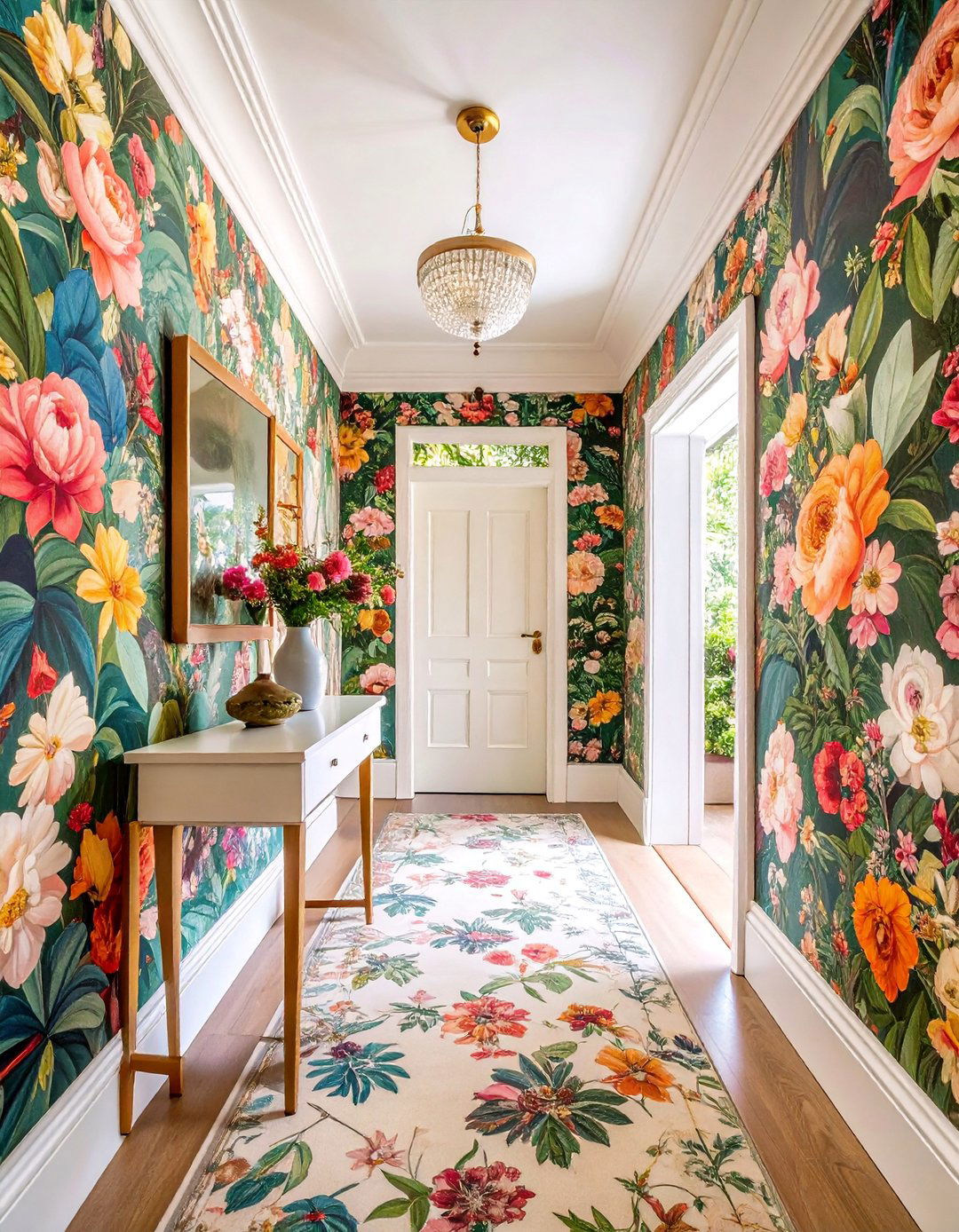
Leave a Reply